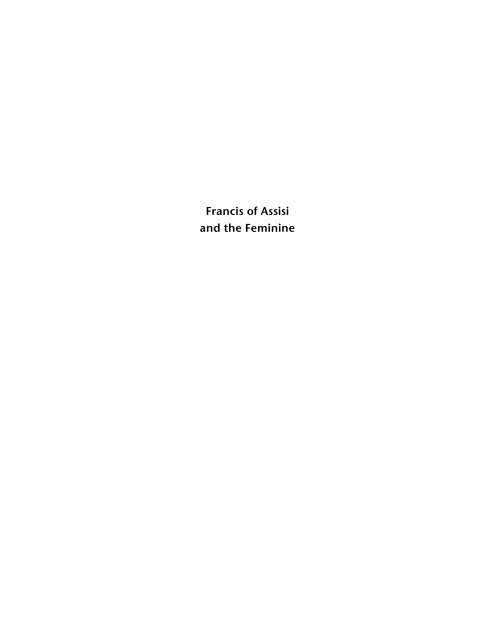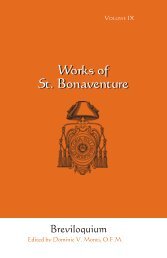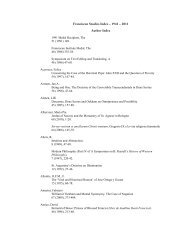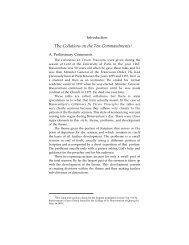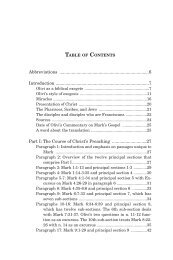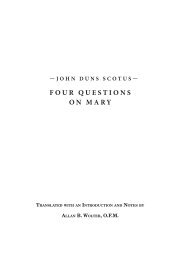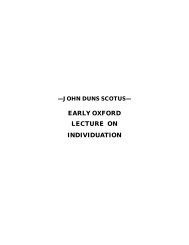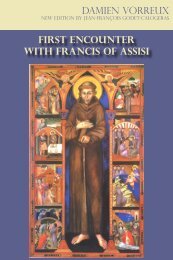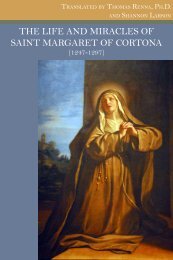Francis of Assisi and the Feminine - Franciscan Institute Publications
Francis of Assisi and the Feminine - Franciscan Institute Publications
Francis of Assisi and the Feminine - Franciscan Institute Publications
Create successful ePaper yourself
Turn your PDF publications into a flip-book with our unique Google optimized e-Paper software.
<strong>Francis</strong> <strong>of</strong> <strong>Assisi</strong><br />
<strong>and</strong> <strong>the</strong> <strong>Feminine</strong><br />
1
3<br />
JACQUES DALARUN<br />
<strong>Francis</strong> <strong>of</strong> <strong>Assisi</strong><br />
<strong>and</strong> <strong>the</strong> <strong>Feminine</strong><br />
<strong>Francis</strong>can <strong>Institute</strong> <strong>Publications</strong><br />
The <strong>Francis</strong>can <strong>Institute</strong><br />
Saint Bonaventure University<br />
Saint Bonaventure, NY 14778<br />
2006
4<br />
Copyright © 2006<br />
The <strong>Francis</strong>can <strong>Institute</strong><br />
St. Bonaventure University<br />
St. Bonaventure, New York<br />
Original title: Francesco: un passaggio. Donna e donne negli scritti e nelle leggende<br />
di Francesco d’<strong>Assisi</strong><br />
© Edizioni Viella, Rome, 1994<br />
French version: François d’Assise: un passage. Femmes et féminité dans les écrits<br />
et les légendes franciscaines<br />
© Éditions Actes Sud, Arles, 1997<br />
Cover illustration: Anonymous <strong>of</strong> Rimini,<br />
Central panel <strong>of</strong> <strong>the</strong> triptych <strong>of</strong><br />
<strong>the</strong> Blessed Clare <strong>of</strong> Rimini, c. 1330<br />
Ajaccio (Corsica), Musée Fesch<br />
All rights reserved.<br />
No part <strong>of</strong> <strong>the</strong> book may be reproduced or transmitted in any form<br />
or by any means, electronic or mechanical, without permission in<br />
writing from <strong>the</strong> publisher.<br />
Library <strong>of</strong> Congress Card Catalogue Number: 2004113195<br />
ISBN: 1-57659-195-6<br />
Printed in <strong>the</strong> United States <strong>of</strong> America<br />
Phoenix Color<br />
Hagerstown, MD<br />
USA
5<br />
Contents<br />
Preface .....................................................................................7<br />
Foreword .................................................................................9<br />
Introduction: <strong>Francis</strong>, Clare, Women ..................................17<br />
Chapter 1: Sparks: The Writings <strong>of</strong> <strong>Francis</strong> .........................29<br />
Chapter 2: Mirrors: The Legends <strong>of</strong> Thomas <strong>of</strong> Celano ......95<br />
Chapter 3: Diffraction <strong>and</strong> Tarnishes:<br />
From <strong>the</strong> Companions to <strong>the</strong> Deeds ..............187<br />
Conclusion: Dispossession .................................................257<br />
Bibliography .......................................................................287<br />
Postscript by Giovanni Miccoli .............................................333<br />
Index ....................................................................................359
7<br />
Preface<br />
Jacques Dalarun first published this study on woman,<br />
women, <strong>the</strong> feminine <strong>and</strong> feminization in <strong>the</strong> life <strong>of</strong> <strong>Francis</strong><br />
<strong>of</strong> <strong>Assisi</strong> in Italian: “Francesco: un passaggio. Donna e donne<br />
negli scritti e nelle leggende di Francesco d’<strong>Assisi</strong>” (Rome:<br />
Edizioni Viella, 1994). In 1997, he published a French<br />
translation, revisited <strong>and</strong> enlarged: “François d’Assise: un<br />
passage. Femmes et féminité dans les écrits et les légendes<br />
franciscaines” (Arles: Éditions Actes Sud). Upon <strong>the</strong> author’s<br />
request, it is <strong>the</strong> French version that has been translated<br />
into English, <strong>and</strong> that <strong>the</strong> <strong>Francis</strong>can <strong>Institute</strong> has <strong>the</strong><br />
pleasure to publish in this book.<br />
This publication is <strong>the</strong> fruit <strong>of</strong> a collective effort. To<br />
Paula Pierce, SFO <strong>and</strong> Mary Sutphin go our thanks for working<br />
on <strong>the</strong> translation from <strong>the</strong> French: it was not an easy<br />
task, given <strong>the</strong> delicate subject as well as <strong>the</strong> subtlety <strong>of</strong><br />
Jacques Dalarun’s language. We are not less thankful to<br />
Roberta McKelvie, OSF <strong>and</strong> Daria Mitchell, OSF for thoroughly<br />
reviewing <strong>and</strong> editing <strong>the</strong> text. Trevor Thompson’s<br />
contribution was a major help <strong>and</strong> deserves a special appreciation,<br />
for <strong>the</strong> long hours he patiently spent (including<br />
several with <strong>the</strong> author himself) adjusting <strong>the</strong> scholarly<br />
notes to <strong>the</strong> publications in English as well as compiling <strong>the</strong><br />
bibliography. And, finally, our gratitude goes also to Alison<br />
More, Ph.D. for her help in <strong>the</strong> elaboration <strong>of</strong> <strong>the</strong> index.<br />
The preparation <strong>of</strong> this book for publication was not an<br />
easy endeavor. It took a lot <strong>of</strong> time <strong>and</strong> energy, but it is our<br />
conviction that, in <strong>the</strong> end, this magistral work <strong>of</strong> Jacques<br />
Dalarun was well worth it.<br />
Jean François Godet-Calogeras, Ph.D.<br />
Editor
Foreword<br />
<strong>Francis</strong>, nothing else, simply <strong>Francis</strong>. It is enough to say<br />
“<strong>Francis</strong>,” <strong>and</strong> everyone knows <strong>of</strong> whom you are talking,<br />
<strong>the</strong> Umbrian saint, son <strong>of</strong> Pietro di Bernardone, <strong>the</strong> man<br />
from <strong>Assisi</strong>, <strong>the</strong> Poverello.<br />
At <strong>the</strong> sound <strong>of</strong> this single name, “<strong>Francis</strong>,” a jumble <strong>of</strong><br />
words, gestures <strong>and</strong> images gush forth from <strong>the</strong> well <strong>of</strong><br />
memories, including those <strong>of</strong> <strong>Francis</strong> stripped bare <strong>and</strong> <strong>of</strong> his<br />
essential nakedness; so many images, <strong>and</strong> sometimes, even<br />
contradictory. Too many meanings attach to events etched<br />
in <strong>the</strong> earliest memories; a wealth <strong>of</strong> symbolism lies behind<br />
<strong>the</strong> writing <strong>of</strong> this simple paragraph. How many saints, how<br />
many famous historical characters, enjoy <strong>the</strong> privilege <strong>of</strong><br />
being immediately <strong>and</strong> irrefutably recognizable from a single<br />
name, detached from those assured facts which provide historians<br />
with at least certain secure facts, such as family,<br />
places <strong>and</strong> dates?<br />
<strong>Francis</strong> is unique <strong>of</strong> his kind, an exception in history,<br />
ever current, possessed <strong>of</strong> an enduring modernity. The first<br />
temptation is to see <strong>Francis</strong> as a boundless, ever present horizon<br />
that can never be reached. Belonging to all times <strong>and</strong><br />
to none, he is a timeless enigma towering above history.<br />
O<strong>the</strong>r people have set out to scrutinize <strong>the</strong> paths he chose,<br />
to plumb <strong>the</strong> depths <strong>of</strong> his mystery, <strong>and</strong> have done it reasonably<br />
well: poets, writers, people <strong>of</strong> faith or conviction.<br />
But historians who would surrender <strong>the</strong>mselves to <strong>Francis</strong>’s<br />
charm must be careful not to succumb to <strong>the</strong> established,<br />
intricately-woven ideological constructions, which <strong>Francis</strong>can<br />
propag<strong>and</strong>a has produced in seeking to turn <strong>the</strong>ir founder<br />
into an exceptional <strong>and</strong> inimitable figure: <strong>Francis</strong> <strong>the</strong><br />
Saint.<br />
9
10 FRANCIS OF ASSISI AND THE FEMININE<br />
Historians exercise <strong>the</strong>ir craft. They historicize. There are<br />
many forgotten figures we would like to resurrect from history,<br />
from <strong>the</strong> obscurity <strong>of</strong> <strong>the</strong> times in which <strong>the</strong>y have<br />
been set. Efforts must be made to retrieve <strong>Francis</strong>, <strong>the</strong> w<strong>and</strong>erer,<br />
bro<strong>the</strong>r to <strong>the</strong> wind. However, a web has been woven<br />
<strong>and</strong> wafted, into an ever-tighter net. From out <strong>of</strong> time, <strong>Francis</strong><br />
<strong>of</strong> <strong>Assisi</strong>, son <strong>of</strong> Pietro di Bernardone who was born in<br />
1181 <strong>and</strong> died on October 3, 1226, returns to time. He fills<br />
his times completely, always holding center stage.<br />
The entire Middle Ages are subsumed in <strong>Francis</strong>, or such<br />
will be <strong>the</strong> impression <strong>of</strong> <strong>the</strong> readers who become immersed<br />
in <strong>Francis</strong>can sources. The more <strong>the</strong>y delve into <strong>the</strong>m, <strong>the</strong><br />
more plentiful materials <strong>the</strong>y will find, concentrated in <strong>the</strong><br />
writings <strong>and</strong> legends, to build <strong>the</strong> man from <strong>Assisi</strong> into a representative<br />
<strong>of</strong> his time <strong>and</strong> period. Medieval life with its<br />
l<strong>and</strong>scapes <strong>of</strong> wild solitude, unchanging rusticity <strong>and</strong> bustling<br />
cities, <strong>and</strong> its social order comprising merchant classes<br />
<strong>and</strong> ambitious aristocracy, self-satisfied wealth alongside absolute<br />
poverty, clerics <strong>and</strong> laity, literate <strong>and</strong> illiterate. In <strong>the</strong><br />
life <strong>of</strong> <strong>Francis</strong>, <strong>the</strong> quintessential medieval man, we find <strong>the</strong><br />
paradoxes <strong>of</strong> <strong>the</strong> period, for which he instinctively found<br />
<strong>the</strong> syn<strong>the</strong>sis – unparalleled conformity to <strong>the</strong> gospel message.<br />
He was a herald <strong>of</strong> <strong>the</strong> future from <strong>the</strong> Reformation to<br />
today’s struggle against poverty, which can be compared<br />
with 13th century misery. We find ourselves new <strong>and</strong> willing<br />
victims <strong>of</strong> <strong>the</strong> extraordinary <strong>Francis</strong>can propag<strong>and</strong>a,<br />
which has celebrated ever more resolutely <strong>the</strong> conformity <strong>of</strong><br />
<strong>the</strong> Poverello “to <strong>the</strong> poor, naked, suffering crucified Christ,<br />
suspended on <strong>the</strong> cross.” 1 <strong>Francis</strong> is not a-historical but<br />
ra<strong>the</strong>r trans-historical because <strong>of</strong> his capacity to encapsulate<br />
<strong>and</strong> assume humanity <strong>and</strong> human history. In what appears<br />
like a contradiction: <strong>the</strong> uniqueness <strong>of</strong> <strong>Francis</strong> is found in<br />
his similarity; his identity in being identical.<br />
Like Christ his model, captured initially in <strong>the</strong> writings<br />
<strong>of</strong> <strong>the</strong> four evangelists before becoming <strong>the</strong> center <strong>of</strong> widely<br />
conflicting interpretations, <strong>the</strong>re are many different interpretations<br />
<strong>of</strong> <strong>Francis</strong>. This is evident in <strong>the</strong> <strong>Francis</strong>can<br />
sources <strong>the</strong>mselves, which, since <strong>the</strong> first century <strong>of</strong> <strong>the</strong> Or-
FOREWORD 11<br />
der <strong>of</strong> Friars Minor, present countless fragmentary images <strong>of</strong><br />
<strong>the</strong>ir founder, forming a mirror shattered with <strong>the</strong> most<br />
complex hagiographical dossiers <strong>of</strong> <strong>the</strong> medieval period.<br />
There are as many images <strong>of</strong> <strong>the</strong> man from <strong>Assisi</strong> as <strong>the</strong>re are<br />
readers. Everyone will manage to find a text, a passage, a<br />
sentence in which <strong>Francis</strong>’s character accords with <strong>the</strong>ir a<br />
priori intuition <strong>of</strong> him.<br />
Today, historians no longer seek to reconstruct a universal,<br />
coherent, single image <strong>of</strong> <strong>the</strong> one true <strong>Francis</strong>, following<br />
<strong>the</strong> rules <strong>of</strong> critical methodology. He has become more inaccessible.<br />
Narrowly defined or <strong>the</strong>matic studies have momentarily<br />
taken <strong>the</strong> place <strong>of</strong> biographies. 2 This present attempt<br />
follows a direct path <strong>and</strong> has a limited goal, aiming only at a<br />
part <strong>of</strong> <strong>the</strong> truth. I believe that given <strong>the</strong> seemingly endless<br />
interpretations <strong>of</strong> <strong>Francis</strong>, I should explain why I have chosen<br />
<strong>the</strong> course I will pursue in <strong>the</strong> following pages. I have no<br />
intention <strong>of</strong> proving that I have made <strong>the</strong> best choice.<br />
Ra<strong>the</strong>r, I want to dispel immediately <strong>the</strong> impression that I<br />
may have discovered, <strong>and</strong> propose, <strong>the</strong> key to <strong>the</strong> secret <strong>of</strong><br />
<strong>Francis</strong> <strong>of</strong> <strong>Assisi</strong> in this personal <strong>and</strong> opportunistic study.<br />
A town does not appear <strong>the</strong> same from every angle <strong>of</strong><br />
approach. The traveler who reaches <strong>Assisi</strong>, having gone<br />
around Mount Subasio, discovers, set in an arid mineral<br />
l<strong>and</strong>scape, a military post, on top <strong>of</strong> which is perched a l<strong>of</strong>ty<br />
citadel that shields <strong>the</strong> city from prying eyes. Whereas, whoever<br />
arrives across <strong>the</strong> plain from Perugia has to mount an<br />
assault on <strong>the</strong> Sacred Convent <strong>and</strong> Saint <strong>Francis</strong> Basilica, as<br />
if trying to board <strong>the</strong> stern <strong>of</strong> a steep-sided ship. I came<br />
across <strong>Francis</strong>, having studied <strong>the</strong> hermits <strong>of</strong> western France<br />
at <strong>the</strong> dawn <strong>of</strong> <strong>the</strong> 12th century <strong>and</strong> also certain holy<br />
women from central Italy at <strong>the</strong> turn <strong>of</strong> <strong>the</strong> 13th <strong>and</strong> 14th<br />
centuries, preferring hagiographical sources or legends. I<br />
freely admit <strong>the</strong> enormous difficulty I found in painting a<br />
coherent picture <strong>of</strong> two centuries <strong>of</strong> medieval religious history.<br />
My attention was drawn to <strong>the</strong> Poverello whilst studying<br />
<strong>the</strong> lives <strong>of</strong> two people in particular, Robert <strong>of</strong> Arbrissel<br />
<strong>and</strong> Clare <strong>of</strong> Rimini. Although <strong>the</strong>y pale in significance be-
12 FRANCIS OF ASSISI AND THE FEMININE<br />
side <strong>Francis</strong>, <strong>the</strong>y drew me to concentrate my efforts on certain,<br />
possibly obsessive, <strong>the</strong>mes.<br />
In 1101 Robert <strong>of</strong> Arbrissel instituted <strong>the</strong> Order <strong>of</strong> Fontevraud<br />
in <strong>the</strong> Loire Valley. In this community for both men<br />
<strong>and</strong> women, something in itself rare, what is unique is <strong>the</strong><br />
fact that <strong>the</strong> men, at <strong>the</strong> express wish <strong>of</strong> <strong>the</strong>ir founder, submitted<br />
<strong>the</strong>mselves to <strong>the</strong> authority <strong>of</strong> <strong>the</strong> women. Since<br />
Jules Michelet, historians <strong>and</strong> o<strong>the</strong>rs continue to be fascinated<br />
by its strange propositum, <strong>the</strong> mainspring behind a religious<br />
experiment which seemed to fly in <strong>the</strong> face <strong>of</strong> social<br />
norms. In fact, it troubled <strong>the</strong> bro<strong>the</strong>rs <strong>the</strong>mselves during<br />
Robert’s lifetime! I followed <strong>the</strong> lines <strong>of</strong> research <strong>of</strong> Jean-Marc<br />
Bienvenu <strong>and</strong> an article by Dominique Iogna-Prat, finding<br />
support in <strong>the</strong> unedited ending <strong>of</strong> <strong>the</strong> second legend <strong>of</strong> Robert,<br />
his Vita altera. I came to underst<strong>and</strong> that this servitude<br />
was conceived by <strong>the</strong> founder <strong>of</strong> Fontevraud as a form <strong>of</strong><br />
extreme humiliation, a salutary penance whereby one submitted<br />
unflinchingly to <strong>the</strong> authority <strong>of</strong> a being regarded as<br />
less worthy.<br />
However, it cannot be denied that, like it or not, this<br />
novel, limited opportunity for women had positive effects<br />
on <strong>the</strong>ir status in medieval society. It was <strong>the</strong> Golden Age <strong>of</strong><br />
<strong>the</strong> 12th century, one generation from <strong>the</strong> Gregorian reform<br />
<strong>of</strong> <strong>the</strong> Church, that decisive moment, described as “acte postgregorien,”<br />
3 by Pierre Toubert. There is an unavoidable ambiguity:<br />
Robert made a propositum for a religious life in which<br />
women, as depicted in a particular underst<strong>and</strong>ing <strong>of</strong> femininity,<br />
were regarded as instruments <strong>of</strong> male ascetism to <strong>the</strong><br />
benefit <strong>of</strong> men. At <strong>the</strong> same time, this gave <strong>the</strong>m <strong>the</strong> opportunity<br />
to come closer to power <strong>and</strong> <strong>the</strong> sacred. Whatever<br />
interpretation you choose, it cannot be denied that<br />
whe<strong>the</strong>r as subjects or objects, women were central to <strong>the</strong><br />
experience lived by <strong>the</strong> Breton hermit.<br />
An exact contemporary <strong>of</strong> Dante, since she probably<br />
died in <strong>the</strong> 1320s, Clare <strong>of</strong> Rimini, needless to say, did not<br />
reach <strong>the</strong> fame <strong>and</strong> notoriety <strong>of</strong> <strong>the</strong> author <strong>of</strong> <strong>the</strong> Divine<br />
Comedy <strong>and</strong> De vulgari eloquentia. She did not even share <strong>the</strong><br />
reputation <strong>of</strong> those holy women closest to her in time <strong>and</strong>
FOREWORD 13<br />
space, Margaret <strong>of</strong> Cortona (†1297), Clare <strong>of</strong> Montefalco<br />
(†1308) or Angela <strong>of</strong> Foligno (†1309). In spite <strong>of</strong> <strong>the</strong> remarkable<br />
study by Guiseppe Garampi, prefect <strong>of</strong> <strong>the</strong> Secret Archives<br />
<strong>of</strong> <strong>the</strong> Vatican, dedicated to her in <strong>the</strong> 18th century,<br />
<strong>the</strong> penitent <strong>of</strong> Rimini remains among <strong>the</strong> neglected, medieval<br />
women characters, even today when we seem so hungry<br />
for sanctity <strong>and</strong> mysticism.<br />
While recently proposing a new edition <strong>of</strong> <strong>the</strong> Italian<br />
legend <strong>of</strong> Clare <strong>of</strong> Rimini, I had <strong>the</strong> good fortune to detect,<br />
word for word <strong>and</strong> step by step, <strong>the</strong> emergence <strong>of</strong> a female<br />
voice in <strong>the</strong> field <strong>of</strong> <strong>the</strong> sacred. Although stuttering <strong>and</strong> still<br />
imprisoned in masculine language, it was, none<strong>the</strong>less, alive<br />
<strong>and</strong> could not be extinguished. The existence <strong>of</strong> this one<br />
example, given that each voice has within it something<br />
which cannot be suppressed, points to a much broader<br />
movement which historians are beginning to perceive more<br />
clearly. This movement followed two directions, <strong>the</strong> appropriation<br />
<strong>of</strong> religion by women <strong>and</strong> <strong>the</strong> feminization <strong>of</strong> religious<br />
<strong>the</strong>mselves, during <strong>the</strong> last centuries <strong>of</strong> <strong>the</strong> Middle Ages<br />
in <strong>the</strong> West. For a long time <strong>the</strong> movement was regarded as<br />
insignificant. It was <strong>of</strong>ten blocked; it was always controlled.<br />
The feminization <strong>of</strong> religion was an ambiguous, complex<br />
process, inseparable from <strong>and</strong> contemporary with <strong>the</strong><br />
movement away from <strong>the</strong> fa<strong>the</strong>r tongue, Latin, used by clerics,<br />
towards <strong>the</strong> development <strong>of</strong> a mo<strong>the</strong>r tongue from all<br />
<strong>the</strong> vernacular dialects. “God changed gender,” ventured<br />
Michelet. 4 The language was crumbling. Lapsus linguæ.<br />
In one region, Fontevraud, <strong>the</strong>re emerged <strong>the</strong> first clear<br />
signs <strong>of</strong> a renewed interest in <strong>the</strong> fate <strong>and</strong>, in part, <strong>the</strong> salvation<br />
<strong>of</strong> women. In ano<strong>the</strong>r, <strong>the</strong> communes <strong>of</strong> Italy, two centuries<br />
after <strong>the</strong> so-called Gregorian period, a little later <strong>and</strong><br />
more hesitantly than in Nor<strong>the</strong>rn Europe, <strong>the</strong> murmur <strong>of</strong><br />
female voices could be detected seeking redemption but also<br />
nurturing genuinely <strong>the</strong>ological ambitions: to speak to God<br />
<strong>and</strong> to speak about God. <strong>Francis</strong> <strong>of</strong> <strong>Assisi</strong> was situated between<br />
<strong>the</strong>se two developments. Robert <strong>of</strong> Arbrissel has sometimes<br />
been presented as a pre-<strong>Francis</strong>can figure. This<br />
description may be debatable but indeed, chronologically,
14 FRANCIS OF ASSISI AND THE FEMININE<br />
<strong>Francis</strong> comes after Robert, <strong>and</strong> not Robert before <strong>Francis</strong>.<br />
The holy women who lived between <strong>the</strong> 13th <strong>and</strong> 14th<br />
centuries were, on <strong>the</strong> o<strong>the</strong>r h<strong>and</strong>, part <strong>of</strong> <strong>the</strong> movement<br />
led by <strong>Francis</strong>. It cannot be denied that, regardless <strong>of</strong> <strong>the</strong><br />
institutions to which <strong>the</strong>y belonged or even if <strong>the</strong>y were<br />
not affiliated to any, <strong>the</strong>ir spirituality reflects many elements<br />
inherited as a result <strong>of</strong> <strong>the</strong> enormous impact <strong>of</strong> <strong>the</strong> man<br />
from <strong>Assisi</strong>. Were <strong>the</strong>y his heiresses, or had <strong>the</strong>y inherited a<br />
later representation <strong>of</strong> him manufactured during decades <strong>of</strong><br />
hagiography <strong>and</strong> pastoral activity? However that may be, it<br />
is simply stating <strong>the</strong> obvious to note that <strong>the</strong>y are undeniably<br />
post <strong>Francis</strong>can. Post hoc, propter hoc?<br />
The causal chain is uncertain – but we are not so much<br />
looking for causes as at relationships. Situated half way between<br />
<strong>the</strong>se two significant developments, does <strong>Francis</strong>, as a<br />
consequence, play a role in <strong>the</strong> respective evolution <strong>of</strong> <strong>the</strong><br />
two genders in regard to religion <strong>and</strong> hence <strong>the</strong> relationship<br />
<strong>of</strong> <strong>the</strong> genders with one ano<strong>the</strong>r? Does he in some way express<br />
<strong>the</strong> change or is he himself <strong>the</strong> channel?<br />
We have believed this to be so <strong>and</strong> have also wanted to<br />
believe that he is <strong>the</strong> essential channel for so many changes:<br />
<strong>the</strong> blossoming <strong>of</strong> art which is realistic <strong>and</strong> accessible to <strong>the</strong><br />
senses, <strong>the</strong> sowing <strong>of</strong> <strong>the</strong> seeds <strong>of</strong> <strong>the</strong> Renaissance, 5 <strong>the</strong> affirmation<br />
<strong>of</strong> individual conscience in <strong>the</strong> face <strong>of</strong> <strong>the</strong> institutional<br />
church, <strong>the</strong> preference for devotion to <strong>the</strong> suffering<br />
ra<strong>the</strong>r than <strong>the</strong> triumphal Christ. In its artistic expression,<br />
<strong>the</strong>se transformations are exactly paralleled in <strong>the</strong> sinuous<br />
<strong>and</strong> languorous feminization <strong>of</strong> <strong>the</strong> figure nailed to <strong>the</strong><br />
wood <strong>of</strong> <strong>the</strong> cross. The book that Chiara Frugoni has just<br />
dedicated to <strong>the</strong> phenomenon <strong>of</strong> <strong>the</strong> stigmata tries to dispel<br />
our last illusions; it puts <strong>the</strong>m into perspective. This essay<br />
does not <strong>the</strong>refore propose to find in <strong>Francis</strong> <strong>the</strong> only key to<br />
two centuries in <strong>the</strong> evolution <strong>of</strong> history. It sets out ra<strong>the</strong>r<br />
to detect, in his writings <strong>and</strong> <strong>the</strong> legends, traces <strong>of</strong> a movement<br />
that could not have failed to involve him, <strong>of</strong> all people.<br />
However famous a person he was, it is not a matter <strong>of</strong><br />
claiming that a priori, one single person alone was <strong>the</strong> guiding<br />
light in <strong>the</strong> transition to a religion made female from
FOREWORD 15<br />
which <strong>the</strong>re would be no turning back, but ra<strong>the</strong>r <strong>of</strong> proposing<br />
to <strong>the</strong> reader <strong>the</strong> possibility that <strong>Francis</strong>, among o<strong>the</strong>rs,<br />
was a channel.<br />
<strong>Francis</strong>can Studies underwent a complete <strong>and</strong> radical revival<br />
through Paul Sabatier a century ago. The “<strong>Francis</strong>can<br />
Question” was born when <strong>the</strong> protestant pastor published<br />
his Life <strong>of</strong> Saint <strong>Francis</strong> <strong>of</strong> <strong>Assisi</strong> in 1894. O<strong>the</strong>r great French<br />
experts, scholars such as Théophile Desbonnets, played a<br />
decisive role through <strong>the</strong>ir work <strong>and</strong> in <strong>the</strong> debate that ensued.<br />
But, frankly speaking, during <strong>the</strong> past fifteen years, <strong>the</strong><br />
most lively research on <strong>the</strong> Poverello has clearly taken place<br />
across <strong>the</strong> Alps. Thus, this book was initially written in Italian<br />
because it was fully charged by <strong>the</strong> dynamism currently<br />
experienced in Italy for historical studies in general <strong>and</strong><br />
<strong>Francis</strong>cans studies in particular. The original edition gave<br />
me <strong>the</strong> opportunity to acknowledge <strong>the</strong> debt I owe to my<br />
Italian colleagues <strong>and</strong> friends in <strong>the</strong>ir own language.<br />
It was never<strong>the</strong>less paradoxical to suggest to a French<br />
editor that he take on <strong>the</strong> translation <strong>and</strong> publication <strong>of</strong> a<br />
text that was nei<strong>the</strong>r conceived nor written in <strong>the</strong> mo<strong>the</strong>r<br />
tongue <strong>of</strong> <strong>the</strong> author. Hubert Nyssen took up <strong>the</strong> challenge<br />
with his characteristic freedom <strong>of</strong> spirit <strong>and</strong> intellectual generosity.<br />
I express my deep gratitude to him.<br />
Lastly, I wish to express how greatly I am indebted to<br />
Giovanni Miccoli, for much more than helping me to overcome<br />
cultural <strong>and</strong> linguistic barriers. Specialists agree in recognizing<br />
that, a little less than a hundred years since <strong>the</strong><br />
<strong>Francis</strong>can Question was opened up, his book, Francesco<br />
d’<strong>Assisi</strong>: Realtà e memoria di un’esperienza cristiana, 6 has essentially<br />
led to a resolution <strong>of</strong> <strong>the</strong> fruitful questions launched<br />
by Sabatier. Without his positive impetus, I could never<br />
have envisioned <strong>the</strong> publication <strong>of</strong> this work. A benevolent<br />
<strong>and</strong> illuminative reader, he suggested a number <strong>of</strong> new directions<br />
<strong>and</strong> areas, where I could delve more deeply, which I<br />
am sure I have not used to full advantage. He has agreed,<br />
moreover, to reproduce <strong>the</strong> substance <strong>of</strong> <strong>the</strong> dialogue we<br />
shared, <strong>and</strong> <strong>the</strong> words we exchanged on <strong>the</strong> way, omnia
16 FRANCIS OF ASSISI AND THE FEMININE<br />
verba quæ diximus in via, in his afterword. From <strong>the</strong> bottom<br />
<strong>of</strong> my heart, I thank him for <strong>the</strong> journey we have traveled<br />
toge<strong>the</strong>r. We are only passengers on this earth.<br />
Notes<br />
1 LMj 14:4. For <strong>Francis</strong>’s writings <strong>and</strong> legends, we will use systematically <strong>the</strong><br />
abbreviations <strong>and</strong> <strong>the</strong> subdivisions <strong>of</strong> <strong>Francis</strong> <strong>of</strong> <strong>Assisi</strong>: Early Documents, R. J.<br />
Armstrong, OFM Cap., J. A. Wayne Hellmann, OFM Conv., W. J. Short, OFM,<br />
eds. 3 vols. (New York: New City Press, 1999-2001). The Latin editions are<br />
indicated below in <strong>the</strong> bibliography. English references are given as FAED <strong>and</strong><br />
volume number.<br />
2<br />
Except for <strong>the</strong> portraits <strong>of</strong>fered to <strong>the</strong> non-specialized public by F. Cardini<br />
[Francesco d’<strong>Assisi</strong> (Milan: A. Mondadori, 1989)] <strong>and</strong> C. Frugoni [Vita di un<br />
uomo: Francesco d’<strong>Assisi</strong> (Turin: Einaudi, 1995); [English trans., <strong>Francis</strong> <strong>of</strong> <strong>Assisi</strong>: A<br />
Life (New York: Continuum, 1998)], <strong>the</strong> last biography is that <strong>of</strong> R. Manselli,<br />
Francesco d’<strong>Assisi</strong> (Roma: Bulzoni, 1980), revised as San Francesco (Milan:<br />
Cinisello Balsamo, 2002); for <strong>the</strong> English version, see St. <strong>Francis</strong> <strong>of</strong> <strong>Assisi</strong> (Chicago:<br />
<strong>Francis</strong>can Herald Press, 1988).<br />
3 P. Toubert, “Église et État au XI e siècle: la signification du moment grégorien<br />
pour la genèse de l’État moderne,” in État et Église dans la genèse de l’État<br />
moderne. Actes du Colloque Organisé par le Centre National de la Recherche<br />
Scientifique et la Casa de Velázquez (Madrid: Casa de Velázquez, 1986), 13.<br />
4 J. Michelet, “Histoire de France: Le Moyen Âge” in Œuvres complètes, vol.<br />
4, 460. P. Viallaneix ed., 21 vols. (Paris: Flammarion, 1971-1982).<br />
5 Henry Thode, Franz von <strong>Assisi</strong> und die Anfänge der Kunst der Renaissance in<br />
Italien (Berlin: Grote, 1885); S<strong>and</strong>ra Migliore, Francesco d’<strong>Assisi</strong>: tra due secoli<br />
1882-1926 (Rome: Istituto Storico Cappuccini, 2000).<br />
6 See Francesco d’<strong>Assisi</strong>: Realtà e memoria di un’esperienza cristiana (Turin: Einaudi,<br />
1991).


